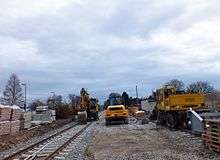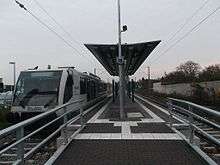Heinsberg (Rheinland) station
Heinsberg (Rheinland) station is a terminus in Heinsberg in the German state of North Rhine-Westphalia and is at the end of the Lindern–Heinsberg railway. The entrance building and the freight sheds were successively demolished in 1997 after the closure of the passenger service in 1980, the end of freight traffic to Heinsberg in 1994 and the closure of the line between Oberbruch and Heinsberg in 1997. In preparation for the reactivation of passenger services on 15 December 2013, a new island platform was erected to the east of the site of the demolished entrance building.
| Terminal station | |||||||||||
_425.104_(33802156235).jpg) | |||||||||||
| Location | Heinsberg, North Rhine-Westphalia Germany | ||||||||||
| Coordinates | 51°03′53″N 6°05′58″E | ||||||||||
| Line(s) | Heinsberg–Lindern railway | ||||||||||
| Platforms | 2 | ||||||||||
| Other information | |||||||||||
| Station code | n/a | ||||||||||
| DS100 code | KHEB[1] | ||||||||||
| IBNR | 8002721 | ||||||||||
| Fare zone | |||||||||||
| History | |||||||||||
| Opened | 1890[4] | ||||||||||
| Services | |||||||||||
| |||||||||||
Location
The station is located on the northeast edge of the town centre. The Heinsberg Galerie, a shopping centre, is next to the station. The station is bordered to the east by the Heinsberg commercial area, where there used to be a siding to a timber yard.
History
1890–1980
Heinsberg gained its first railway connection in 1890 with the construction of the Heinsberger Bahn (Heinsberg Railway), also called Wurmtalbahn (Wurm Valley Railway).[5] After long consideration of the possibilities for extending the railway, the station was built as a terminus. The entrance building was then located on the area that is between the current bus station and medical centre. It was almost identical with that of the neighbouring Dremmen station, but the signal box was in the entrance building and not in a glass annex, as in Dremmen. There were two waiting rooms in Heinsberg. A freight-handling facility was established directly next to the reception building with its own loading track.
The station was destroyed in the Second World War. The remains of the entrance building were demolished and were never rebuilt, instead a wood shed was built as a temporary station. The rail tracks were rebuilt by volunteers.
A new entrance building was opened in 1951 with a separate freight area to its south. On the tracks and the platform there was a glass annex, similar to at the Dremmen station. This contained a signal box and the ticket office. All part of the platform were covered. There was also a canopy over the entrance from the street. Passenger traffic was handled on only one track and the remaining tracks were used for freight and sidings to the timber yard and the gas works. The passenger traffic was abandoned in 1980. A few years later, the entrance building was demolished to make way for a new bus station. The track layout was partly demolished to make room for the Heinsberg-Galerie.
Since 2010




Heinsberg was originally intended to be reopened for rail traffic in 2008, but due to reductions in subsidies, the reactivation of the railway line was delayed, so that the reactivation was then due in 2012.[6] In October 2011, the first edition of the West-Express, a publication of the infrastructure manager Rurtalbahn, announced that a Park and Ride facility would be built in Heinsberg. The journey time from Lindern to Heinsberg, including stops, would be 17 minutes.
The Heinsberg–Oberbruch section was cleared in the spring of 2010. The Zug der Erinnerung ("train of memory", a memorial to children deported by train as part of the Holocaust) was able to run over the line to the Heinsberg Kreishaus (district house) in the same spring. With the clearance of the tracks of this section, their bad condition became clear. Above all, it was impossible to run over the points in the Heinsberg station area.
In June 2012, the old railway tracks were removed at Heinsberg station, the remains of the loading ramp and the remaining foundations of the freight-handling facility were demolished and a new level area was created. The new railway tracks, platform and car park were built on the levelled area.
The car park, the platform and the platform canopy were largely finished in July 2013. To ensure that the traffic to the station does not have to pass through the town centre, the parking lot is only accessible by car via an access road from Industriestrasse.
Since 15 December 2013, the Rhein-Niers-Bahn has run from Heinsberg towards Aachen Hauptbahnhof hourly. The trains are coupled or split in portions at Lindern station.[7][8]
| Line | Route | Frequency |
|---|---|---|
| RB 33 | Heinsberg (Rheinl) – Heinsberg Kreishaus – Heinsberg-Oberbruch – Heinsberg-Dremmen – Heinsberg-Porselen – Heinsberg-Horst – Heinsberg-Randerath – Lindern – Geilenkirchen – Übach-Palenberg – Herzogenrath – Kohlscheid – Aachen West – Aachen Schanz – Aachen Hbf Status: December 2016 timetable |
60 min |
Bus connections

Numerous buses run from Heinsberg station in different directions. Line 493 runs to Lindern as a substitute for the rail service on weekdays. The buses are operated by West Energie und Verkehr and the RVE. At the bus station there are three buses platforms and two taxi ranks.
Freight yard
In addition to the freight facilities of the station, the timber yard and gas works still had their own connections. The siding to the gas plant has been closed and dismantled and the siding to the timber yard has also been closed but it has not yet been dismantled (as of 2011). Since the freight traffic was stopped only five years after the passenger traffic, only the entrance building was rebuilt, not the freight facilities. This was demolished in 2003. Today's station has signs of the loading ramp for goods and sugar beet. The foundations of the freight facilities was still clear until August 2012. With the resumption of passenger traffic all the tracks between Oberbruch and Heinsberg were relocated. The former sidings and other tracks to the old freight yard were removed.
References
Footnotes
- Railway Atlas 2017, p. 208.
- "Liniennetzplan Region Heinsberg" (PDF). Aachener Verkehrsverbund. 1 January 2020. Retrieved 12 June 2020.
- "VRS-Gemeinschaftstarif" (PDF) (in German). Verkehrsverbund Rhein-Sieg. 20 April 2020. p. 201. Retrieved 9 May 2020.
- Joost, André. "Heinsberg (Rheinl) station operations". NRW Rail Archive (in German). Retrieved 16 June 2020.
- Bindels, Johannes (24 March 2014). "Der Heinsberger Bahnhof im Spiegel der Zeit". Aachener Nachrichten (in German). Aachener Zeitungsverlag. Retrieved 9 February 2017.
- "Target network of the AVV for 2012". Aachener Nachrichten (in German). Aachener Zeitungsverlag. 1 March 2008.
- "Staatssekretär und 300 Gäste bei der Jungfernfahrt". Aachener Nachrichten (in German). Aachener Zeitungsverlag. 15 December 2013. Retrieved 9 February 2017.
- Joost, André. "Heinsberg (Rheinl) station". NRW Rail Archive (in German). Retrieved 16 June 2020.
Sources
- Frenken, Wilhelm (1982). "Die einhundertjährige Geschichte des Personenverkehrs auf der Eisenbahnstrecke Heinsberg-Lindern". Heimatkalender des Kreises Heinsberg (in German).
- Melchers, Willi (2008). "Der Zirkus kommt". Heimatkalender des Kreises Heinsberg (in German).
- Tetz, Willi (2007). "Lindern und die Bahn". Heimatkalender des Kreises Heinsberg (in German).
- Eisenbahnatlas Deutschland [German railway atlas]. Schweers + Wall. 2017. ISBN 978-3-89494-146-8.
External links
- "Current timetable of Heinsberg(Rheinl)" (in German). Deutsche Bahn. Retrieved 9 February 2017.
- "Departure monitor". Abfahrt Heinsberg, Busbahnhof (in German). Aachener Verkehrsverbund. Retrieved 9 February 2017.
- "Heinsberg Busbahnhof" (PDF; 324 KB). Haltestellenlagepläne (in German). Aachener Verkehrsverbund. December 2016. Retrieved 9 February 2017.
- Reinhard Gessen. "Reaktivierung Heinsberg-Lindern". Bergbau und Eisenbahnen in der Region Aachen-Düren-Heinsberg (in German). Reinhard Gessen. Retrieved 9 February 2017.
- Stefan von der Ruhren (26 September 2016). "Kursbuchstrecke 456 Lindern - Heinsberg". Eisenbahnen in Aachen und der Euregio Maas-Rhein (in German). Stefan von der Ruhren. Retrieved 9 February 2017.